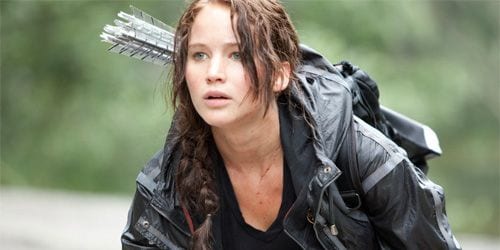
Making a film adaptation of a beloved book series is largely a thankless job. There are infinitely more ways to anger fans than to please them. For every moment that’s altered or abandoned, there are readers out there who would site that moment as their favorite part.
This goes double for The Hunger Games, where the book’s first-person narration makes everything so interior. Suzanne Collins’s novel was solely from the point of view of Katniss Everdeen (Jennifer Lawrence), a teenager living in futuristic Panem, a country still feeling the scars of a revolution that happened nearly three-quarters of a century ago. Panem is divided into 12 districts that exist to serve its Capitol. As punishment for the previous rebellion against the Capitol, every year each district must present two young tributes — one male and one female — to the Hunger Games, a brutal, televised fight to the death with one surviving victor. Katniss is sent to the games with fellow district resident Peeta Mallark (Josh Hutcherson), and has to figure out how to ensure her survival in a culture of horrific violence.
That’s a lot to chew on, and the book covers a lot of ground, from wealth inequality to the media’s desensitization to violence. It’s a good thing, then, that the adaptation landed in the hands of a director as confident as Gary Ross. He understands that the movie should stand for itself, as opposed to functioning as a staged reading of the novel.
The most important shift, and ultimately the most successful one, is the decision to liberate the movie from Katniss’s point of view. The movie is thankfully voiceover-free — which would’ve been a cheap, easy way to sneak in both Katniss’s reactions and Suzanne Collins’s words — and actors’ facial expressions are allowed to stand-in for pages of inner monologue. The universe of the movie unfolds without being over-explained. Ross trusts his actors’ performances to get across the information we need to know without necessarily saying it, and he trusts the audience to absorb all of the movie’s nuances without underlining every revelation and reaction.
The movie takes full advantage of the move to a more third-person perspective. Unlike, say, Chris Columbus’s adaptation of the Harry Potter novels — which slavishly tried to capture every moments of its source material and nothing else — Ross opens up the story a little, filling it in where it may have been too thin. In the book, Katniss only has knowledge of what’s going on within the games, and even that’s limited. Ross pulls back to show the conversations between the game-makers, like the cold-as-ice President Snow (Donald Sutherland) and the smarmier Seneca Crane (Wes Bentley), bedecked in rococo facial hair. We’re looking in on an entire world, as opposed to the problems of a single character.
More important than realizing how to expand the story, Ross knows exactly what elements of the novel to abandon. The novel takes place in a futuristic society, but the movie does away with science fiction. Gone are machines that magically cook up any kind of food in seconds, wealthy Capitol-dwellers who find tinting their skin green in vogue, and the mutant hybrid dog monsters created by the Capitol for the Games. (They’re just run-of-the-mill killer dogs, here.) Ultimately, these details are distancing. Without their inclusion, we can imagine the events of the Hunger Games taking place in a future — but a future that’s not too far off from the present.
In fact, The Hunger Games, if anything, creates a feeling of immediacy. Ross liberally employs the shaky, handheld camera that’s de rigueur for action movies today, and it serves to root the audience in the ground with Katniss, eliminating some of the space that was created when the narrative was taken out of her head. Instead of the stark, shiny environments of most future-set movies, The Hunger Games looks more like our past — costume designer Judianna Makovsky told Entertainment Weekly that she wanted the clothes in District 12 to have a “mid-century, 1930s to ’50s feel — Americana.”
This isn’t to say that nothing gets lost in Ross’s translation. He does give in to the occasional temptation of thorough exposition. Without voiceover or narration to rely on, he resorts to clunky commentary from television newscasters, Caesar Flickerman (Stanley Tucci) and Claudius Templesmith (Toby Jones). Time is devoted to making sure that Gale (Liam Hemsworth) — the third point in the Katniss-Peeta-Gale love triangle who doesn’t really get much to do until future installments of the story — has time to glower at his romantic rival while watching him on television. And, most importantly, even though it’s called The Hunger Games, you never really get the sense of poverty and desperation in the districts. (This could be because the young cast’s camera-ready good looks read more as “bombshell” and “heartthrob” than “starving” and “impoverished”.) Even the Games themselves are sped up so they seem less grueling. In the book, Katniss spends days looking for water; this is skipped over in the movie.
If you doubt any of Ross’s decisions, though, you can’t say he doesn’t justify himself on DVD. A second disc of extras includes more than half a dozen behind-the-scenes features covering every aspect of filmmaking. For the most part, these are all twice the length they need to be, and include too many of the same clips from the film, though hardcore fans might enjoy them. Still, the case for this adaptation hardly needs to be made. Ross ensured that the movie of The Hunger Games speaks for itself.

![Call for Papers: All Things Reconsidered [MUSIC] May-August 2024](https://www.popmatters.com/wp-content/uploads/2024/04/all-things-reconsidered-call-music-may-2024-720x380.jpg)



